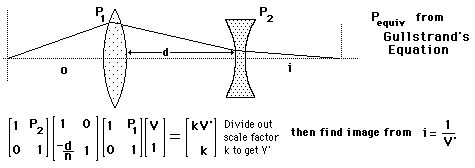System Matrix: Two Thin Lenses
This page is under construction - the Javascript calculation will be added.
The position of the image formed by a pair of thin lenses can be found by the matrix method. This involves multiplying a vector form of the incident vergence successively by matrices representing the refraction by the first lens, the translation to the second lens, and the refraction by the second lens. In this way the exit vergence is determined and from that vergence, the image distance.

A pair of thin lenses can be characterized by their powers and their separation.
|
The vergences can be calculated from the lens parameters and the object distance.The change in vergence when the light encounters a thin lens is equal to the power of the lens.
Using the Cartesian sign convention, the object distance is typically a negative number since it points opposite to the direction of light travel.
| Object distance o = m |
Performing the indicated matrix multiplications gives the exit vergence from the pair of lenses.
 | = |  |
The exit vergence from the final lens determines the image distance with respect to that lens.
| Image distance i = m |
The equivalent power for the pair of lenses can be calculated from Gullstrand's equation:
 | = |  |
Note that the calculation does not take into account the change in lens separation with the angle of the incoming ray. It is typical to do the calculation only for the paraxial rays where the departure from full separation is negligible.
| Vergence Example | Matrix definitions | Example for a thick lens |
Lens concepts
Thick lens concepts
| HyperPhysics***** Light and Vision | R Nave |

